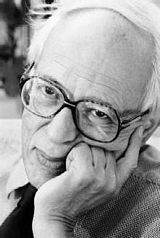Former Faculty: ABRAHAM PAIS

Member, Particle Physics, School of Natural Sciences, September 1980–June 1981; Faculty, School of Mathematics, September 1950–June 1963; Member, School of Mathematics, January 1946–August 1950
Pais was one of several physicists who formed a separate working group within the School of Mathematics in the 1950's and 1960's (the School of Natural Sciences was not established until 1966).
- * PhD: University of Utrecht, 1941
- * Born: May 19, 1918 in Amsterdam, The Netherlands; Deceased: July 28, 2000
Career Highlights:1
- * In 1952, Dr. Pais proposed a concept called "associated production" to explain why certain particles lived for unexpectedly long times before decaying. The particles, he suggested, were produced rapidly in pairs, but neither could decay quickly on its own.
- * Dr. Pais collaborated with Dr. Murray Gell-Mann of the Santa Fe Institute in New Mexico in a theoretical paper in 1955 showing that what seemed to be a single particle could actually be a sort of superposition of two different particles, each with a different lifetime and decay mode....the prediction eventually led to an experiment by Dr. James Cronin and Dr. Val Fitch in 1964 that won them both a Nobel Prize.
- * After becoming fascinated by some research into old scientific papers that he happened to undertake in the 1970's, he shifted his interests to the history of science, writing acclaimed biographies of Einstein (Subtle is the Lord: The Science and the Life of Albert Einstein, published in 1982 and winner of the 1983 American Book Award) and of Bohr (Niels Bohr's Times, published in 1991).
Awards/Prizes include:
- * Robert Oppenheimer Memorial Prize (1979)
- * Physics Prize of the Dutch Physical Society (1992)
- * Medal of Science of the Royal Dutch Academy of Sciences (1993)
- * Gemant Award of the American Physical Society (1994)
1excerpts from his on-line obituary (published by The New York Times)